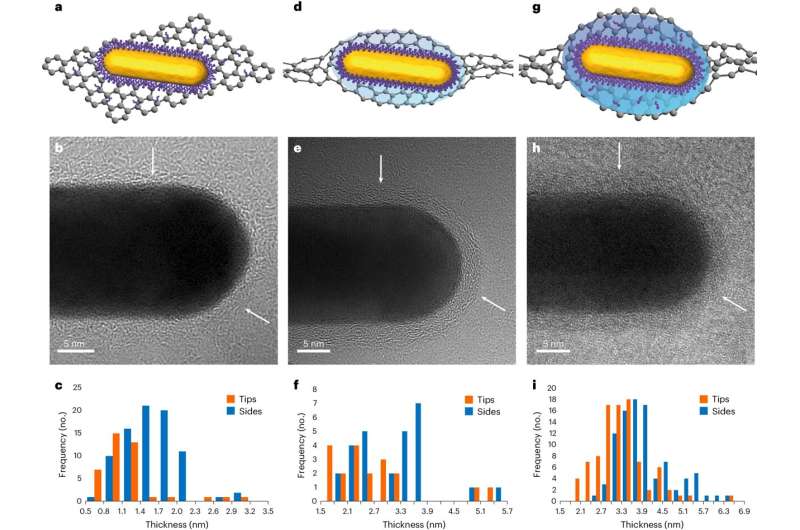This article has been reviewed according to Science X's editorial process and policies. Editors have highlighted the following attributes while ensuring the content's credibility:
fact-checked
peer-reviewed publication
trusted source
proofread
New method visualizes ligands on gold nanoparticles in liquid

The University of Antwerp and CIC biomaGUNE have come up with a promising method for understanding the role of surface molecules in the formation of nanoparticles. The groundbreaking research, published in Nature Chemistry, provides an advanced characterization tool for the design of nanomaterials.
Gold nanoparticles have been the subject of intense research for several decades due to their interesting applications in fields such as catalysis and medicine. "Surface ligands" are organic molecules typically present on the surface of gold nanoparticles. During synthesis, these surface ligands play an important role in controlling the size and shape of the nanoparticles.
For several decades, the CIC biomaGUNE team led by Ikerbasque Research Professor Luis Liz-Marzán has studied in detail the growth mechanisms and properties of these nanoparticles.
Despite numerous advances that have recognized the importance of surface ligands, many questions remain about their exact behavior during and after growth. Direct observation of surface ligands and their interface with gold nanoparticles has therefore been a long-standing goal for many scientists in this field.
Direct visualization of ligands on gold nanoparticles in a liquid environment
Transmission Electron Microscopy (TEM) is the technique most widely used to investigate nanoparticles. However, the study of surface ligands by means of TEM presents significant challenges; the reason is that the ligands are sensitive to the electron beam, their contrast is limited and their structure in vacuum differs from their native state in solution.
To overcome all these difficulties, the collaboration between Liz-Marzán's team at CIC biomaGUNE and the team led by Professor Sara Bals of the University of Antwerp (Belgium) has enabled a new method to be developed to characterize surface ligands by means of TEM in a liquid environment.
The team encapsulated gold nanorods surrounded by ligands routinely used in synthesis between two sheets of graphene, thus creating a small liquid cell. This setup allowed them to take advantage of the exceptional properties of graphene as a sample support for TEM.
Graphene not only enhances TEM imaging, it also reduces electron beam damage due to its excellent thermal and electrical properties. That way, the research team was able to visualize the ligand shell and determine its composition.
The results of the study have provided fresh insights into the structure of the surface layer formed by the ligands. In particular, the real-time observation of a micelle (a small cluster of ligands) moving and colliding with an adjacent gold nanorod challenges the model of a possible static and uniform ligand layer.
The method proposed in the study opens up multiple opportunities to understand the role of surface molecules in the formation of more complex nanoparticles, such as chiral nanoparticles, whose growth mechanism remains largely unexplored (chiral particles can preferentially absorb light from a given polarization, with respect to the nanoparticle of opposite chirality).
In addition, this method shows promise for studying the so-called "protein corona" that forms around nanoparticles dispersed in biofluids, which will be crucial in designing new diagnostic and therapeutic strategies for the treatment of diseases.
This research not only advances the understanding of the interactions between gold nanoparticles and ligands, but also provides an advanced characterization tool for the design of nanomaterials and their applications in various fields of nanotechnology, such as nanomedicine, catalysis or sensing.
More information: Adrián Pedrazo-Tardajos et al, Direct visualization of ligands on gold nanoparticles in a liquid environment, Nature Chemistry (2024). DOI: 10.1038/s41557-024-01574-1
Journal information: Nature Chemistry
Provided by CIC biomaGUNE




















